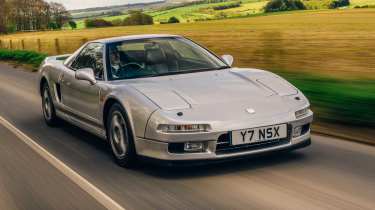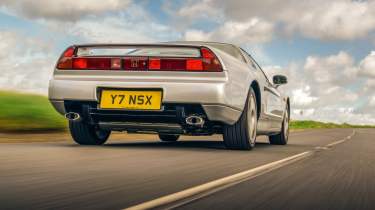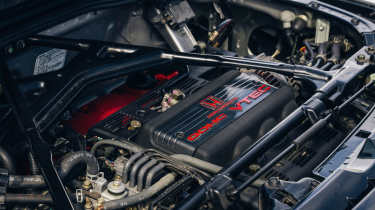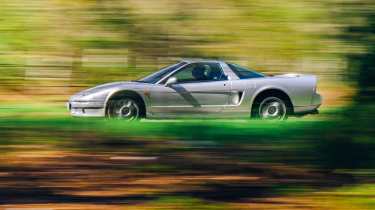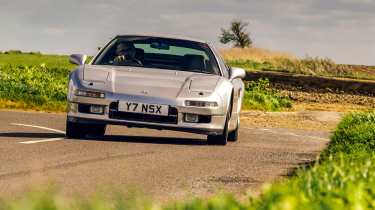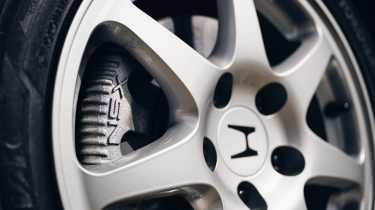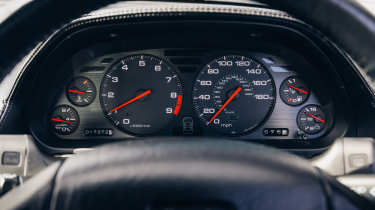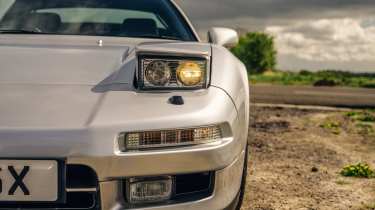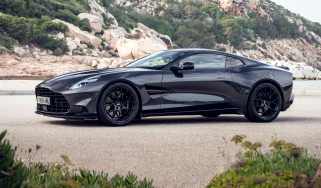Used Honda NSX (1999 - 2006) review: Japan's original supercar
Thirty-five years ago, the sports and supercar world was turned on its head by the launch of Honda’s sublime NSX. We retrace its origins and rediscover its enduring magic
'Kinell!’ I exclaim, as the 3-litre V6 kicks again, perfectly judged gearing keeping it in the VTEC zone, the smooth, rev-hungry V6 continuing to thump the NSX down the road with a force that seems far in excess of the quoted 270bhp. Yes, old cars are much lighter – the NSX weighs around 1400kg – but this engine is making light of even that. And the acceleration doesn’t seem to be waning as it goes up through the gears, hence the involuntary expletive.
It’s been many years since I drove a standard NSX and I recall it was a great engine, but this is something else; it feels feistier than any NSX‑R I’ve driven. This 1995 car has covered fewer than 18,000 miles and has just had a new clutch and belts at considerable cost, so perhaps it’s ‘just run‑in’. It’s riding on brand new tyres too, so I’m intrigued to discover if the dynamics are as sweet as I recall.
> Used Honda Accord Type R (1998 – 2002) – review, history and specs of the forgotten Japanese icon
Thirty-five years ago, the NSX arrived like a bolt from the blue and immediately set new standards for mid-engined cars and sports cars generally. However, being the best in any field isn’t always a guarantee of commercial success. This is especially true when it comes to emotional purchases, and for car buyers it doesn’t come much more emotional than choosing a sports car. Ability is all very good but there’s reputation to consider, and heritage, plus nebulous concepts like image. Sports car choice is not some sort of meritocracy, so even if you have the most able, most technically advanced and highest quality product, you can’t expect customers to beat a path to your showrooms.
More reviews
Honda probably knew all of this when it set out to build what would become the NSX, but what’s an ambitious car-maker supposed to do? You can’t take on European sports car royalty head-on: only Porsche can build a car with the engine in the wrong place, only Ferrari can get away with selling a car that won’t go into gear properly until it’s warm. So Honda looked forward and made the car that Porsche or Ferrari might have made if they’d started from scratch.
The progenitor of the NSX is often cited as the HP‑X, the Honda Pininfarina eXperimental concept, revealed at the Turin Auto Show in 1984. It had a mid-mounted, 2-litre V6, as found in Honda’s then-current Formula 2 race car, and featured ground-effect aerodynamics and carbonfibre and Kevlar construction, though its most striking feature was a one-piece Perspex canopy in lieu of doors. Recently, the concept was restored and went on display at the 2024 Pebble Beach Concours d’Elegance.
However, the NSX arguably owes more to the Austin Rover Group. Honda was collaborating with ARG in the ’80s and at Frankfurt in 1985 the Brits revealed the striking MG EX‑E concept to widespread acclaim. It boasted a Cd of just 0.24, had an advanced, bonded aluminium spaceframe chassis and was powered by a mid-mounted 250bhp V6. Sounds like the NSX, doesn’t it? Now google it and take a look at its styling. The stark reality for ARG was that it was far too exotic for them to put into production, but the management wouldn’t let it go. Four years later, Honda revealed the NSX.
In summer 1990, the crucial US market got its first taste of the NSX, branded Acura there, and we at Performance Car took a story from our US correspondent that prompted the cover line ‘Drives like a Ford, goes like a Ferrari’. A more accurate and flattering description would have been ‘Drives like a Honda…’ but, you know, sub-editors love alliteration.
I was dispatched to Germany for the European launch. The pre-drive press conference was fascinating because it focused on how the NSX had been developed to be as easy to handle as any other Honda. This extended not only to ease of use of the controls – steering, gearshift and pedals – but also to the excellent driving position, outstanding visibility and, crucially, the dynamics. The Honda engineers talked us through graphs and charts showing how the suspension and its geometry had been configured and tuned to protect the average driver, behaving benignly if the driver bottled out mid-corner and snapped the throttle shut.
Although low and sleek, the styling was tidy rather than thrilling, the front end a little bland despite the pop-up headlights, the rear overhang, shading a pair of weedy tailpipes, rather bulky because the boot was big enough for a set of golf clubs (gotta love the US market). My colleague, Brian Laban, nailed it when he described the Honda as ‘crypto-Ferrari’. But beneath the skin the NSX was fantastically exotic; it was the world’s first series-production car with an aluminium monocoque, a decade ahead of Ferrari. There were forged aluminium control arms for the double-wishbone suspension found at each corner, too.
Initially, the 3-litre V6 wasn’t going to have Honda’s VTEC system, which seems absurd now, but at the time Honda was benchmarking Ferrari’s 328, which had just 266bhp. Thankfully, VTEC was fitted late on, even though it compromised the engine installation. It almost instantly proved its worth, because as the 270bhp NSX was launched, the 328’s successor arrived: the 296bhp 348.
Yet while the junior Ferrari supercar was the inspiration, the Porsche 911 was the NSX’s closest rival. The 964-gen Carrera 2 was priced at a little under £50k, the NSX a little above it, while the 348 was a few hundred quid shy of £70k. The 911 and NSX (and Nissan 300ZX) met in the April ’91 issue of Performance Car, on road, on track (Thruxton) and at Millbrook, where performance figures were extracted. In many ways it was a close contest. The 911, already 30 years old by this stage, won for the usual reasons: character, tactility, compactness, challenging but rewarding handling, and then carried on for the next 30 years largely as if the NSX had never happened. It was the car that wasn’t on that test, the 348, that was most impacted by the Honda’s arrival.
I can’t recall, but I suspect our request for a 348 was denied. Not having it there was no great loss, though. Four months earlier we’d tested the 348 against the 328 and discovered that the older car drove better. The photoshoot was cut short by the editor spinning the 348 and damaging the front splitter, sending him scuttling back to Maranello Sales to explain himself. That’s the reverence Ferrari was held in. Truth was, the 348 looked more modern than the 328 thanks to its Testarossa side-strakes, but dynamically it didn’t move the game on. It felt like a model born of complacency, a complacency that was mercilessly exposed by the NSX, which didn’t so much move the goalposts as pack them up and ship them to another county. Still, the shockwaves that ran through Maranello resulted in the F355, which was so much better than the 348, setting new standards of approachability and driveability in a Ferrari, so we should be grateful to Honda for that.
Getting back into a stock NSX after many years, the interior has aged gracefully, looking neat and stylish, while the driving position is instantly excellent, with seat, wheel and pedals perfectly aligned. The all-round view is outstanding for a mid-engine car; the Pininfarina one-piece canopy of the HP‑X concept might have been a fantasy, but Honda was inspired by the F-16 fighter and its bubble canopy. The scuttle is low and gives a great forward view, yet while the cockpit looks airy, it feels a little tight. In profile, the NSX is a wedge and it’s getting thin where you sit, so although you are slung low, the facia and instruments are low, too, so you do feel a little like you’re sitting on the car.
Beyond the small-ish steering wheel is a set of brilliantly clear instruments with red needles in the Porsche style. A little closer, a collection of lumpy-looking stalks sprout from the column, placing vital switchgear within sight and touch, which is neat, though at first I’m indicating with the wipers because the NSX was from a time when Japanese cars hadn’t adopted the European stalk conventions.
Twist the key and the V6 behind rouses with a light, slightly tappety drawl. As a general rule, naturally aspirated V6s feel a bit gruff and rev reluctantly, but as soon as you step on the throttle this one feels super-eager, like it has no internal inertia. Titanium con-rods (another production car first) help foster that feeling and there are other trick parts including torque-enhancing variable-length intake tracts. The sensation of easy-spinning eagerness is further magnified by perfectly spaced gearing and, of course, it was a pretty lightweight car. No lighter than the 964 Carrera, despite all the aluminium, but the NSX casts a much bigger shadow and these days 1370kg feels featherweight.
The V6 is keen from low revs, gets stronger in the mid-range and then smoothly but thrillingly ramps up the urgency at 6000rpm as VTEC switches to the higher-lift cams. The red line is at 8000rpm and the limiter at 8300, by which time the howl from behind is utterly glorious. The gearshift is slick, accurate and wrist-flick light, and the next ratio drops the revs to 6000rpm, right back to the start of the VTEC zone. You get the impression that if there were no speed limits you’d be well on the way to the 168mph top speed before the acceleration started to tail off.
Famously, this isn’t a car that’s tied down by stiff suspension. It breathes with the road and there’s a deftness to the ride that makes light of patches of turbulent asphalt, allowing you to carry speed. The steering is quite light when you make small inputs on a meandering road, while the underlying feeling is one of calm composure, the zingy V6 crooning away behind you, compressing the straights.
This pristine ’95 car, owned by Ravi Bansal, is a rare combination of targa top, manual gearbox and the later, upsized alloys. The original version’s pastry-cutter five-spokes were 15 inches front and 16 rear; these handsome seven-spokers are an inch up in diameter. There’s also a six-speed manual gearbox in place of five, and electric power steering. There were structural changes for the T-top, an extra 45kg of strengthening to restore torsional rigidity, and some suspension mods too: stiffer front springs but a thinner anti-roll bar and softer rear springs plus firmer dampers.
This is the only NSX‑T I’ve driven and in corners it doesn’t feel quite as poised as the non-Ts. The steering feels almost non-assisted when you heft it into a corner, the efforts ramping up significantly. Unusually for a car of this era, there is traction control and you can switch it off, but I’m not minded to do that, discouraged by the thought of winding on opposite lock when the efforts are quite high. Of course, it’s never been that sort of car. The NSX is at its very best effortlessly devouring a flowing road, perfect gearing and easy heel-and-toe shifts keeping the V6 singing, all the mass feeling low-slung, the responses precise, assured. There was nothing quite like it back in the day and there still isn’t.
The NSX was the most accomplished car of its generation but, as we said, that’s no guarantee of commercial success. Celebrity endorsement didn’t seem to shift the dial either. Gordon Murray famously used one for benchmarking the McLaren F1 and Ayrton Senna owned three, apparently. You can still see the much-viewed YouTube video of him wringing out an NSX‑R around Suzuka in loafers and white socks.
The NSX also won many accolades. In its impressive lifespan, it was Performance Car’s Car of the Year twice, winning in ’91 at a canter (defeating, among others, the 964 RS!), and again in 1995 (993 Carrera), while the sublime NSX‑R won eCoty in 2002 (996.2 Carrera 4S). And yet here in the UK it sold in tens while the 911 sold in the hundreds.
In 16 years, fewer than 20,000 NSXs were delivered worldwide. Kudos to all those who bought one. Everyone else, you need to put aside your prejudices and preconceptions and get behind the wheel.
What to look out for
Most NSXs will have been well looked after, but expert knowledge is vital to their wellbeing. The NSX might be as dependable as a Civic, but its running costs are more like a Ferrari’s thanks to parts prices. Graham Horgan of NSX specialist Plans Motorsport says that while the basic servicing is not dear, there’s usually something else to be done, and owners should expect to spend £1000 a year on maintenance. The US is a source of cheaper parts, though: ‘Typically they’ll cost the same in dollars as pounds,’ he says.
Engine
Hondas are well known for oil-tight engines, so view leaks with suspicion. There should be a hardening of engine note and a surge of power as the revs rise; if not, then something is amiss with either the VTEC variable valve-timing and lift system or the VVIS variable-geometry intake plumbing.
It is highly recommended that the camshaft pulley is replaced when the cambelt is changed (every five years or 60,000 miles). Failures of the camshaft pulley can cause either poor running if the belt just slips a notch or two, or, far worse, valve damage if it breaks or fails completely.
Transmission
Nothing much to worry about apart from listening for untoward whines from bearings, including the input shaft bearing which might grumble in neutral with the clutch engaged. The gear change should be light and positive. Early five-speed gearboxes numbered between J4A4-1003542 to J4A4-1005978 might have a faulty countershaft bearing snap ring which could cause major gearbox failure. If possible, check it has been replaced. That said, if the car has now covered a big mileage the chances are it’s okay.
Suspension and wheels
Suspension balljoints, bushes and bearings do wear, especially if the NSX has been driven hard on track. This hurts if it’s a front lower balljoint, because you have to buy the whole upright at around £1000. The other parts are pricey, too. Plans Motorsport can convert an NSX’s suspension to NSX-R specification, involving springs (stiffer front, softer rear), dampers, anti-roll bars and rear lower wishbones. One effect is to reduce the pendulous oversteer to which a standard NSX ultimately succumbs. Check the tyres for wear – the rears don’t last long.
Body
It’s aluminium, and any repairs must have been done by someone familiar with working the metal and making sure the paint bonds to it properly. Check inside the nose and tail for repairs, overspray, non-original seam sealer and other evidence of impact. Corrosion is not a problem, but panel gaps should be perfect. Make sure all the locks, catches and the pop-up headlights (if applicable) work, remembering that the cost of replacing even insignificant items can be very high if they are NSX-unique.
Interior
The cabin’s furnishings are very durable but check everything works and be worried if any warning lights don’t extinguish when they should. The Bose stereo is unique to the NSX, so if you’re looking at a car with aftermarket sounds and you want to reinstate its originality, be prepared to spend an easy £1000 here.
What to pay
NSXs are rare so you may have to wait a while to find the right one for you. At the time of writing in 2025, there are in the region of 250 cars in the UK, of which over 150 are SORN. Given their rarity, even early cars will now set you back from £60,000, with the very best, low c10,000-mile later cars currently on the market for in the region of £150,000.
'I bought one'
‘At the time the NSX came out I was friendly with my local Honda dealer, and they had a white one in. I was drooling… “Take it for a run,” they said, “and don’t bend it.” I fell in love. I knew that one day I’d have to have one.
‘I bought this car in 2006. It’s a July 2003 car which had done only 4000 miles from new. I used it as a daily driver to begin with, covering 19,000 miles up and down the country, but after 19 months I realised it was too good to blat around the country. Now it lives in a barn under a cover, but the last two years we’ve driven it down to Poitiers in France. It gets an amazingly positive reaction wherever we go. Sometimes it’s “Like your Ferrari!”.
‘It’s the most undemanding of cars, and not a thing has gone wrong with it. Most Honda garages don’t have NSX people any more, but I get it serviced at Norton Way Honda in Letchworth. In the last four years the bills have been £195, £585, £272 and £247. That’s not bad for a supercar.’ – Barry Harber
Honda NSX (NA1) specs
| Engine | V6, 2977cc |
| Power | 270bhp @ 7300rpm |
| Torque | 210lb ft @ 5400rpm |
| Weight | 1370kg (1415kg Targa) |
| Power to weight | 200bhp/ton (194bhp/ton Targa) |
| Tyres as tested | Yokohama Advan Fleva |
| 0-62mph | 5.9sec |
| Top speed | 168mph |
| Basic price new | £55,000 |
| Value today | £70,000-80,000 |
With thanks to owner Ravi Bansal. This story was first featured in evo issue 334.

